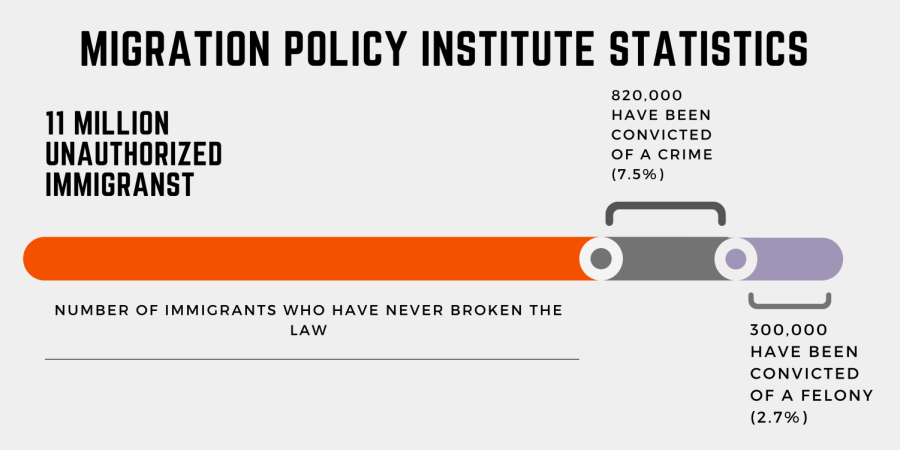A brief look at immigration in America
July 20, 2022
America is a melting pot of culture and diversity: from the streets of Queens, New York, to Silicone Valley, California. America is the land of dreams, where people flock, so their dreams too can come true. But, this is an idealistic version of America. Instead, we live in a country full of xenophobia and uncertainty, where life is a gamble for an immigrant: a worst-case scenario and sometimes the best, only to leave a motherland in the hopes of a small generational win. This package will aim to briefly examine and expose you to the nuances of such a controversial yet straightforward issue.
What is Immigration? A personal reflection.
The Oxford language dictionary defines Immigration as the act of coming to live permanently in a foreign country. But, to immigrate means to be an immigrant.
Being an immigrant means consistently working 10 times harder than everyone in the room and living in fear, knowing that you might get a “visa denied” email followed by a heartbreaking phone call one day. Informing you that you must leave the country you have come to love as your own.
Immigration is a lottery – so it is about living for our brothers and sisters that never made it here. Immigration is about dreading the day your parents die… because you know you won’t see them say a final “goodbye.” It is about saving the bonuses or extra money earned to see your family in your home country while all your peers globetrot to Cancun or Spain.
Immigration compromises for family – so a mother can pass a test to show she is already qualified and see a father start over, hoping for a better life. Immigration is diminished and belittled – “what is that?” “your accent is funny!” or worst of all…
“Go back; you don’t belong here.”
Immigration is about hanging your head down, not causing trouble (because maybe the trouble will be brought up in your citizenship hearing), and waiting patiently even though the country you have given everything to makes you wait, wait and wait.
Immigration is about smiling ear to ear when someone you meet is from the same place as you – maybe I can finally be seen. Immigration is about never belonging… Not in a home country, not in America.
While everyone works a summer job by the beach, immigration is about not having a social security number: Does America not recognize an immigrant?
Immigration is about fighting for everything: your job, your visa, your house, your car, your teachers, your grades, your language, your culture, your beliefs… just everything.
Immigration is hoping that once citizenship is confirmed, there is safety, protection, and the qualification to be someone’s first choice.
What is illegal immigration?
Think for a moment… Remember the news. “The influx of Immigrants will take American jobs, lower our wages, and especially hurt the poor,” the news lady reads.
Immigration doesn’t have to be a bad thing. It can be a good thing to increase the potential economic output resulting in an increased size of the labor force.
Immigration becomes a strenuous task for the government only when people arrive undocumented: these people are called illegal immigrants.
An illegal immigrant is an immigrant who has entered the country in a way that violates the immigration law of that country.
The best estimates say that 11 million illegal immigrants labor in American fields, atop half-built towers, restaurant kitchens, and swelling American classrooms, detention centers, and immigration courts.
In society’s mind, undocumented Hispanic people living here without permission from the American Government are primarily Mexican and have crossed the southwestern border secretly.
In the eyes of advocates, they are families and workers; they are hard-working breadwinners, laboring the jobs that no Americans want in the hope of staying out of trouble and earning their way to better, safer lives.
At the White House, they are outcasts in society, criminals who corrupt American neighborhoods, pounce on American jobs, derive American resources, and exploit American generosity: They are people who should be, and will be, removed from American society.
There may not be a more powerful symbol of how fixedly Americans associate illegal immigration with Mexico than the wall President Trump had proposed building along the southern border. But many of the unauthorized are not Mexican; almost a quarter are not even Hispanic.
Even the wording of the issue reveals: that conservatives favor the term “illegal immigrants.” Immigrant advocates prefer “undocumented immigrants,” a phrase that returns the conversation to humans who want better lives. “Unauthorized” often shows up as an alternative naming system for advocates and conservatives.
No matter their name, undocumented immigrants do not think of themselves as lawbreakers.
The Migration Policy Institute has estimated that 820,000 of the 11 million unauthorized have been convicted of a crime. About 300,000, or less than 3 percent of the 11 million undocumented, have committed felonies.
Out of all the stories and newsreels watched, the key takeaway is that no one wants to leave their country until they have to; people don’t come to America and intentionally overstay their visas. With all the push and pull factors, it is always a more severe and precarious matter than what is presented by the regular newsreels.
Why America should extend permanent legal status to unauthorized immigrants
The United States is renowned for being the land of immigrants: where dreams come true. Except for Native Americans, the vast majority of Americans are immigrants, the descendants of immigrants, or enslaved people. This diversity has translated directly into American culture through cuisine, language, and the arts, among many other influences. The seamless integration of cultures woven into American society reinforces the power America possesses internationally.
Immigrants also make an essential contribution to the U.S. economy. Most directly, immigration increases potential economic outputs by increasing the size of the labor force.
Furthermore, Immigrants contribute to increasing productivity. Economists find that immigrants are more mobile than natives in response to local economic conditions, perhaps because of “fewer long-standing familial and community ties, helping labor markets to function more efficiently. Immigrants boost innovation, a critical factor in improving living standards.” Specifically, a one percentage point increase in the population share of immigrant college graduates increases patents per capita by 9 percent to 18 percent.
The Department of Homeland Security (DHS) estimates the population of unauthorized immigrants to be roughly 11 million. This estimate that researchers’ use include beneficiaries of Deferred Action for Childhood Arrivals (DACA) and Temporary Protected Status (TPS), even though both groups have legal authorization to temporarily live and work in the United States. This diverse population includes individuals who either entered without passing through immigration (unauthorized entry) or legally came to the United States temporarily and then overstayed their visas. Most individuals may not legally work or receive safety-net benefits—or only under substantial restrictions.
Allowing unauthorized immigrants a permanent legal status would guarantee a certain degree of freedom to pursue and take up jobs for which their passion and skill levels align. Rather than being restricted to the economy’s agricultural, construction, leisure, and hospitality sectors, where wages are significantly lower. For example, around one-half of workers in the U.S. dairy industry—which in 2018 paid between $11 and $13 an hour for general labor—are immigrants, most of whom are thought to be unauthorized. Without legal status, job mobility and opportunity are significantly restricted: a critical pathway in ensuring that workers find more excellent and productive employers over their careers that personally benefit American society and themselves is obtaining legal status.
Many comparisons of earnings made by various economists suggest a disparity in job opportunities between authorized and unauthorized immigrants causing skills and talent to be misallocated, reducing productivity.
Taking a brief look at immigrant influences in American society
For all you Google lovers: it is a lifesaver for random trivia and ten-page research reports. The phrase “google it” is now iconic. Google, one of America’s most reliant tools, was co-founded by Sergey Mikhaylovich Brin, a Russian immigrant in a rented garage with his partner Larry Page.
Now, let’s google ‘Tour de France’ – the most famous bike race in the world annually held in France. Fair right? Yes, considering that Pierre Lallement, a French immigrant invented the bicycle.
Immigrants have contributed to America’s history and culture but have always gone unnoticed, despite impacting the world with their monumental inventions. America, the melting pot of culture and vitality, would not be what it is today without the ingrained values – “hard work and grit will make you big” – setting the foundation for the modern American dream.
Hamburgers, hot dogs, football, baseball, and bubble gum are all American staples that are just iconic American things that immigrants invented; many people will be surprised to find, which really isn’t all that shocking considering immigrants built the United States – when Dutch and British settlers colonized America. These undervalued immigrants epitomize the American dream.
Now, let us google “what cars are owned by Americans?” Most cars are foreign: Volkswagen is German, Toyota is Japanese, Fiat is Italian. And the English alone are responsible for BMW, Jaguar, Rolls Royce, and Bentley.
Google “American patriotism.” Washington D.C. is the first thing that will come up. You have the Pentagon, the Supreme Court, Capitol Hill, and the most patriotic attraction of all – the White House, which was designed by an Irish immigrant, James Hoban. Even more patriotic than the White House is “God Bless America,” written by a Jewish immigrant, Irving Berlin from Belarus.
Google “Football,” not ” soccer,” as Americans call it – I mean “American Football.” The one originated from rugby, a wildly popular European staple on game day. Rugby has a huddle just like football, but players are only allowed to use their feet like in soccer. Rugby also has far less equipment and padding partially because rugby players don’t tackle headfirst. Its popularity reaches 25 countries that in turn compete in the Rugby World Cup, excluding qualifying tournaments.
Now, google “the most popular movies.” Everyone will recognize the iconic panoramic view of the New York City skyline in the opening scenes that will undoubtedly include Lady Liberty that the French gifted to Americans in 1886. ‘What about the skyscrapers and the Brooklyn bridge, you may ask?’ Well, German immigrant John Augustus Roebling provided the wonderful view.
Continuing on about the big apple and diversity in cuisine, Next time you are in New York or you are watching ‘Other guys,’ be sure to look out for the famous Coney Island hot dog stand – you can thank German immigrant Charles Feltman, for introducing the renowned staple and for the annual hot dog eating contests that can only be pulled of by America.


